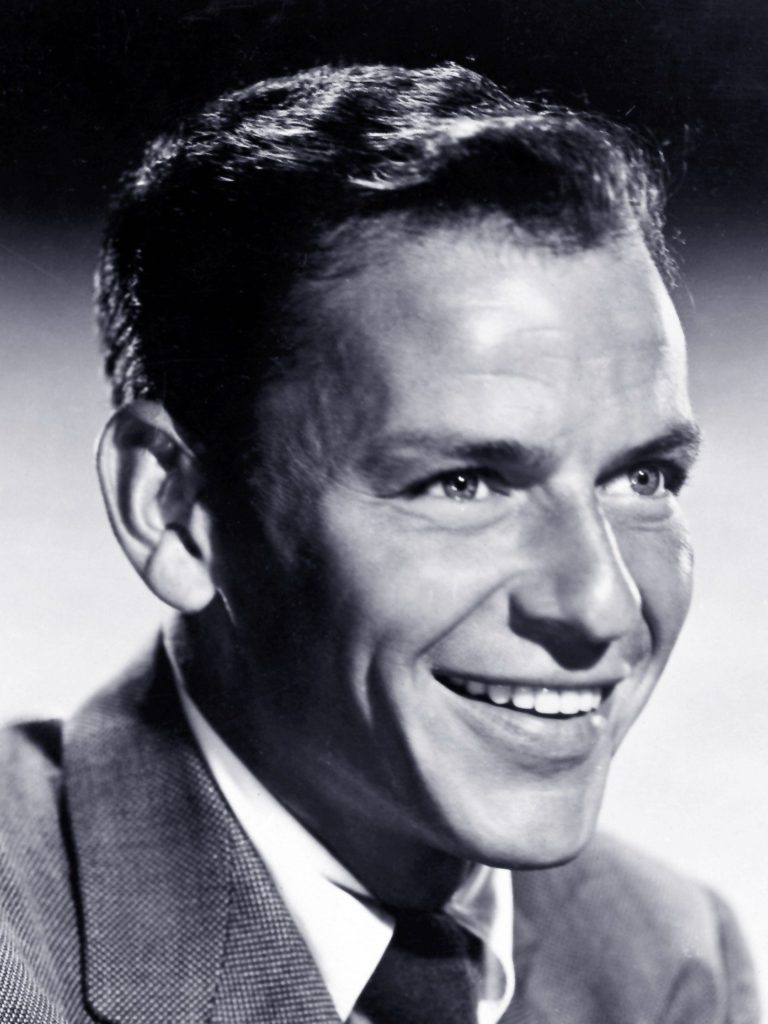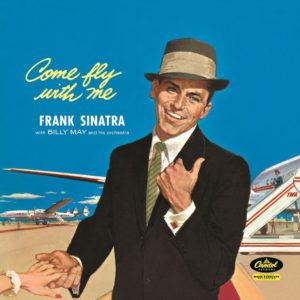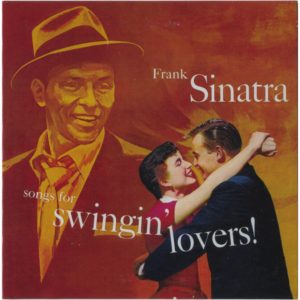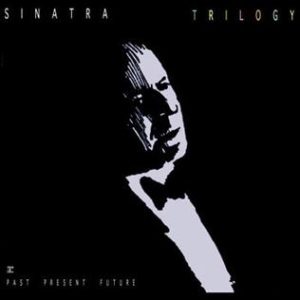
Francis Albert Sinatra was born on December 12, 1915 in Hoboken, NJ. Just across the Hudson River from Manhattan. I was born more than 60 years later, in Michigan. Born in a suburb of Detroit City, which is just across the Detroit River from Windsor, Canada. In other words, I have very little in common with Frank Sinatra. Yet he is easily my favorite singer, my favorite musical performer. He is the greatest singer of all time. How did I become a fan of Old Blue Eyes, when everyone else my age was listening to Nirvana, Pearl Jam, and Stone Temple Pilots?
Frank Sinatra was born to Italian immigrant parents. The beginning of his life is probably similar to the stories of many people born in the early part of the 20th Century in the New York area. Whether it was Queens, the Bronx, or New Jersey. All of those immigrants from Europe, jammed together into that great metropolis of Gotham. Living in the shadows of the center of the universe, Manhattan. The allure of high finance, Wall Street, Broadway, radio, and television all just a subway ride away. The potential for fame and fortune was so close, literally minutes away, yet it was a million miles away from the humble surroundings of their working-class lives. Sinatra would eventually drop out of high school, after being expelled for “general rowdiness”. He would work various odd jobs, both in and outside of the entertainment world. From delivering newspapers to working as a riveter in a shipyard. He would sing at restaurants and at radio stations, often for free.
Sinatra knew he enjoyed singing, ever since he received a ukulele as a gift as a teenager and would entertain the family with it. Eventually, his odd jobs kept focusing more and more on the realm of singing. He practically forced himself into a trio, turning it into the Hoboken Four. The group let him in the band only because Sinatra owned a car and they could use him for the purpose of getting from point A to point B. It was then that they discovered he actually had tremendous vocal range, and before long they won a radio contest. This led to a small tour of supper clubs, restaurants, and radio stations. Soon, it became apparent that this skinny kid named Sinatra had something special. The voice, the charisma.
Bandleader Harry James heard that voice and brought Frank Sinatra into his group. Sinatra had grown up listening to big band music and idolizing Bing Crosby. This was the first big step towards manifesting his dreams into reality. Harry James eventually led to Sinatra singing with Tommy Dorsey’s big band, which was the preeminent big band in that era. He was part of the Pied Pipers, a group of singers which accompanied Tommy Dorsey’s band. Sinatra quickly grew into a soloist performer with Dorsey, even appearing as a singer in films which featured Dorsey’s band. He was the featured name, and eventually was ready to truly go solo.
The method by which Frank Sinatra gained his musical independence is somewhat legendary. It is legendary that no one really knows if the legend is true or not. Tommy Dorsey had an ironclad contract with Sinatra, including a percentage of his future earnings. Sinatra grew up in an Italian neighborhood, and some of his friends ended up in the Mafia. Rumor has it that one of his old neighborhood friends put a gun to Tommy Dorsey’s head and soon after that Dorsey released Sinatra from his contract. Is it true? I think only Sinatra and Dorsey know for sure. This legend is the basis for a storyline in the motion picture, The Godfather.
Sinatra went solo, and Sinatramania soon followed. Girls screaming, bobby socksers famously fainting in the aisleways while he performed. He appeared in a couple of big musical films, Anchors Aweigh and On The Town, portraying a Navy seaman on shore leave in both films, one taking place in New York, the other in Los Angeles.

While he had seemingly hit the highest heights during this timeframe in the 1940’s, his fortunes would soon change. As WWII ended, Sinatra’s popularity would nosedive. Fame and fortune proved fickle, and the adoration of teenage girls soon moved on to the next big thing. Sinatra had been declared 4-F for military service, meaning he was not eligible to be drafted into the war effort for medical reasons. He would entertain the troops on USO tours, but I can’t help but think that many troops were none too pleased to see their girlfriends back home swoon over Sinatra while they were fighting in Europe and the Pacific. As they returned home, maybe they were not too keen to be a fan of the one that had stayed behind.
Sinatra continued to record music for Columbia Records, and while there are some gems during his Columbia era, for the most part he was already a has been as the 1940’s drew to a close. He even turned somewhat gimmicky with some of his music, releasing “The Hucklebuck”, a dance fad song, and later on “The Rock and Roll Waltz”. He was divorced from his first wife, had a floundering career, damaged his vocal cords and was fearful that his career might be permanently over, and there may have even been a suicide attempt or two according to some biographies. He then met and fell madly in love with the person that would eventually become his second wife, actress Ava Gardner. Make no mistake, at this time in their careers, Ava was the big star. Sinatra was the has-been. As a favor to Ava, after much pleading with the studio, Sinatra was cast in the film From Here To Eternity. It was the beginning of his great comeback. He would win the Oscar for Best Supporting Actor. (Sinatra had previously won an honorary Oscar in 1945 for the movie short, The House I Live In, a patriotic plea for tolerance during the height of WWII. He would also later be nominated agaun for acting in The Man With The Golden Arm, an ahead of its time and rather dark film in which he portrays a heroin addict.)
From Here To Eternity was the catalyst that brought forth the Golden Age of Sinatra. If you’ll pardon my going off on a tangent for a moment, I know in my life there will be television shows that I enjoy watching. Then the shows maybe lose some quality in later years, plus I grow tired of seeing the same repeats over and over, and eventually I tune out. Inevitably, five years later or so, I stumble back on the show I used to love, and I re-remember how great it truly was. I think something similar happened to Sinatra. WWII had ended, and suddenly he just was not “cool” any longer. But down the road, people started to remember how good of a singer he had been. And still was. From Here To Eternity put Sinatra back in front of the pop culture zeitgeist. People were ready to love him again.
Another important factor in Frank Sinatra’s comeback was that he switched from Columbia to Capitol Records. I am guessing that 75% of the Sinatra music that casual fans may be familiar with was released during the Capitol era. It is the quintessential Sinatra sound. The richness in his voice and the maturity with which he sings during the Capitol years is 2nd to none. This is a grown man singing with wisdom about the world. The arrangements and the orchestration are both top-notch during his time at Capitol. I can’t even imagine how wonderful it would have been to walk into the legendary and iconic Capitol Records Building in Hollywood to see Sinatra singing along live with the orchestra.
I’ve read numerous times that Frank Sinatra is the best of all time when it comes to “phrasing”. I’m not musically-inclined to even pretend to know what that means. I also once read that Sinatra said he focuses on singing the words on the page more than the notes on the page. Again, I’m not entirely certain what he means, but I believe he focused on singing the words in a specific manner, to ensure that the story of the song was most impactful with the listener.
Another important element of the Capitol years is the rise of the Sinatra concept album. The idea being that all the songs on an album would have a similar theme and tell a story. Which maybe does not sound like an earth-shattering idea by today’s standards, but at the time it was a new idea. Before that, Sinatra did not have albums. He had singles, released on 78rpm records. If you think back to the early rock and roll era, Elvis Presley’s first albums or even something like Meet The Beatles, those are more of a collection of songs. The idea that the album itself should tell a story was not the approach taken by record companies before that time.
My favorite Sinatra concept album is Songs For Swinging Lovers, which starts off with songs about those first few moments of the excitement of falling in love (You Make Me Feel So Young), leading up through songs about marriage and finally towards the end of the album songs about having children (Making Whoopee). Another favorite Sinatra concept album of mine is Come Fly With Me. In which Frank takes us on a whirlwind tour traveling around the globe, leading us back home with the last song (“It’s So Nice To Go Traveling… but it’s oh so much nicer to come home”). One more note about the Capitol years, is the artwork on the album covers. These truly are works of art, worthy of being hung on a wall in a museum.
Sinatra the singer slowly morphed into Sinatra the legend in the 1960’s. He would leave Capitol Records, where he was so fertile in creativity, in order to create Reprise Records. He figured why should the record companies make so much money off of me, why don’t I just become the record company myself? This would earn him one of his other nicknames, the Chairman of the Board. Because he literally was the Chairman of the Board. At that point a lifelong Democrat (he would later, like many Democrats of his era, become a Republican Ronald Reagan supporter), he fully and wholeheartedly embraced John F. Kennedy’s bid for the Presidency in 1960. What is real, and what is legend, who knows for sure, but rumor has it that Kennedy asked for Sinatra’s help. Help with his old Italian neighborhood friends in helping to secure the proper results at the ballot box. Those friends were persuasive with various unions, and those unions helped to secure West Virginia for Kennedy over Nixon in the 1960 Presidential Election, thereby securing the electoral college victory for JFK. Further rumor has it that when JFK’s brother, Attorney General Robert Kennedy, started going after the Mafia, those old neighborhood friends of Sinatra were none too pleased. They voted on whether to remove Frank from this world permanently as punishment for his enabling of the Kennedys. Thankfully, Frank won that vote.
Sinatra’s life in the 1960’s seems almost mythical. He is friends with Presidents, he has a private jet in an era when barely anyone owns such things. He invests and owns casinos, his music is popular, his movies are popular. (A few personal favorite films of mine from that era. Suddenly, in which he portrays a person trying to assassinate the President which had the unfortunate circumstance of being released right near the assassination of JFK. It was, needless to say, not a popular film at the time but in hindsight is quite a good film. Von Ryan’s Express is another good one, about a hijacked locomotive of POWs trying to escape from Germany in WWII. None But The Brave, another WWII movie, about GI’s trying to make peace with entrenched Japanese soldiers on a Pacific island. And probably my favorite movie that he ever made, The Manchurian Candidate, about North Korean Communists brainwashing a soldier to turn him into a secret assassin.) The 1960’s continued, his mystique continued. Sinatra’s daughter became a music star. His son was kidnapped and held for ransom. He basically created the Las Vegas aura, singing at the Sands Hotel with his Rat Pack lifelong friends Dean Martin and Sammy Davis Jr. He would create movies with them all day (the original Ocean’s 11 film, Robin and the Seven Hoods), and perform in the nightclubs with them all night.
He kept making new music, he kept traveling the globe performing everywhere. It would later be revealed that the CIA would use him to help transport files and people all over the world. Because there was no better cover than Frank being Frank, trotting across the globe. Nobody paid any mind to what else might be on the plane with him. He married, divorce, remarried, re-divorced again. Towards the end of the decade and into the 1970’s, he retired. I think he was just tired. He had done it all, achieved all of his dreams, became a star in the 1940’s, and lost it all. Then he did it again, not just a star this time, but a supernova. Living a life that even other celebrities couldn’t dream of, becoming a myth, almost a caricature of himself.
But the retirement was short-lived, a few years later he came out of retirement, putting on a concert, a live album, The Main Event Live, in the round at Madison Square Garden. Howard Cosell introducing him like a boxer coming out to the stage. Frank coming out in a robe, the boxer coming out to defeat the audience once again.
There is a clip of Johnny Carson discussing Frank Sinatras appearance on The Tonight Show in that timeframe, in which Johnny says, this is the first time he had been nervous since he first started doing the show. That The Tonight Show Band had actually dressed up and everyone was anxious because Frank was there, Frank would be performing. He was in the building. Everyone was anxious with anticipation, and wanted to be on their “A game”. Sinatra somehow, for some reason, has that quality. “It”. That mystique. Other big-name entertainers noticed and felt it too. That Sinatra was on a different level of fame.
The late 70’s would bring maybe the biggest song in Sinatra’s career, “Theme From New York, New York”. A song that has taken on a life unto itself as the theme for the great city of Gotham. The city that Frank used to look across at from Hoboken, NJ. Now it is played after every New York Yankees game, after the ball drops in Times Square on New Year’s Eve. It is the song that Jerry Seinfeld has played right before he takes the stage in any city, because it’s the song that means it’s time. Time to perform, time to excel. Time to try and live up to Frank’s standards.

I was a kid in the 1980’s. Frank Sinatra was once again not “cool”. My first memory of anything related to Sinatra was, of all things, the movie License To Drive starring Corey Haim, Corey Feldman, and Heather Graham. At one point, the guy and the girl are about to dance, and the only music he can find in the car for them to dance to is Sinatra’s Strangers In The Night. There is a joke in which he says something like, “oh great, Grandpa’s greatest hits”. The implication being that this music was old and lame. Beyond that, all I knew about Sinatra at this point was Phil Hartman’s impersonation of him on Saturday Night Live. Again, making him seem kind of old and lame. Almost mean-spirited.
My older brothers listened to Led Zeppelin and Stevie Ray Vaughan. I listened to Oldies radio as a kid. That was more like The Four Seasons, Rolling Stones, and Elvis though. Not really the Sinatra era. But my dad listened to Sinatra. I’m not even sure if I liked the music at all then, but I must have enjoyed it on some level. Unknowingly acquired a taste for it as I heard it in the background of my basement as I played Nintendo while my Dad worked in his office.
A few years later, I was then in junior high, listening to MC Hammer and Vanilla Ice. New Jack Swing was in full effect. Boyz II Men, ABC, BBD. Paula Abdul, early 1990’s. I go to the mall one day, am in the music store, go to posters and look at Cindy Crawford in a bikini for a while, and then I go browsing. Next thing I know I bought Sinatra Reprise: The Very Good Years. I don’t even know why I bought it. I listened to it and I loved it. The voice, the songs, the everything. I don’t even know why I loved it. But I could not stop listening to it. This greatest hits cassette would become my most favorite, most listened-to album of all time. I sheepishly mentioned it one day at school, the world had embraced grunge by this point, that I was really was into Frank Sinatra. Much to my surprise, somebody else said, “yeah, I own that album too. Great album.”
Little did I know, that a world away, Jon Favreau and Vince Vaughn were making the movie Swingers. Apparently, swing music and that era were now the underground, cool thing to listen to in the bars of California. I had no idea that, for once, I was sort of ahead of my time. Soon Swingers would be released, and unleash that swing, retro thing in the late 1990’s. Claymation Sinatra appeared in advertisements for Lipton Iced Tea. Louis Prima music was selling khakis for The Gap. The Brian Setzer Orchestra was selling out shows. It was a fad, and eventually it went away. But there are those of us that still love that era of music, and we all discovered that we weren’t alone. We’re still out there, still loving that era of music. The fad is long gone, the people that embraced it as a fad have long since moved on. But that’s okay. I feel as if it made it okay to like that era once again. It’s not old, it’s not lame. It’s wonderful, and it can be appreciated without being mocked by SNL.
Frank Sinatra died on May 14, 1998. The same day that Seinfeld’s last episode aired on NBC. But the music lives on, and one way I think his music, and his era of music, lives on is during the most important times of our lives. At wedding receptions, whose music is usually played while everyone eats dinner? It’s Frank Sinatra, Dean Martin, Tony Bennett. At Christmas, whose music is listened to quite often? Again, it is Sinatra, Bing Crosby, Nat King Cole. During the truly most meaningful moments of our lives, they are there, still providing our soundtrack.
Dean Martin is the coolest cat around. Bing Crosby is the original crooner. Tony Bennett is still out there making music. Sammy Davis Jr might be the most talented one of them all. Nat King Cole might have best voice. But let’s be perfectly Frank, there is only one Sinatra.
– MTR
You can follow MTR on Twitter and let him know what you think.
For even more Sinatra, you can check out my list of Top Ten Frank Sinatra songs
